
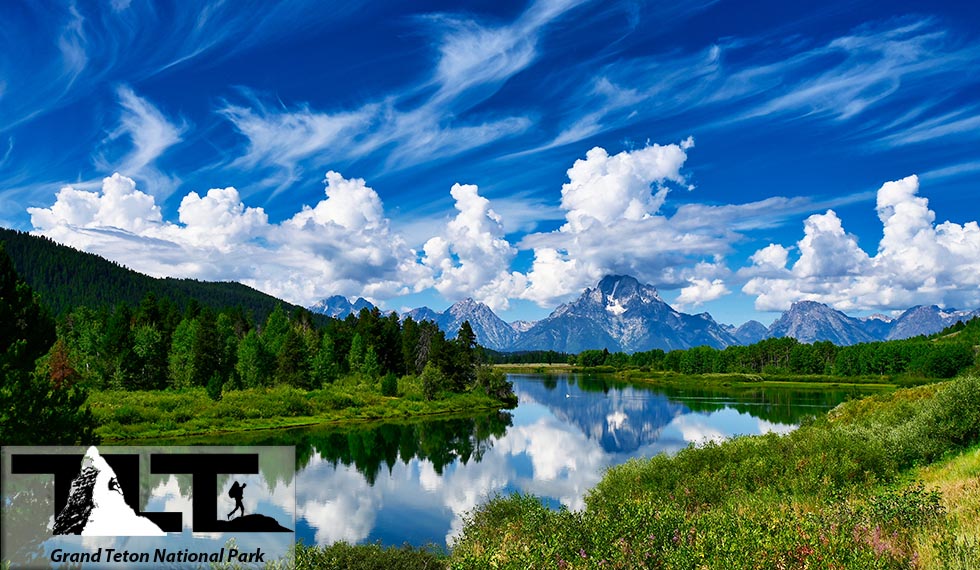
Grand Teton National Park in Wyoming, is one of the most beautiful parks in all of North America. With activities such as kayaking, fly-fishing, horseback riding, rafting, scenic hiking, and challenging climbing on sound rock, there is something for everyone. Whereas most other ranges are obscured by foothills, the Tetons rise abruptly as much as 7,000 feet from the flat plains of Jackson Hole and culminate in the 13,770 foot summit of Grand Teton. The "Grand" is the highest peak in the park, and the second highest in the U.S. State of Wyoming. People come from all over the world to climb in the Tetons, and with the
multitudes of routes available, it is hard to imagine any climber coming away disappointed.
If you like river rafting, kayaking, canoing, or any of the other various water activities, the Snake River offers plenty of opportunities, and the stunning views that you will be treated to are nearly unrivaled anywhere else on the continent. And last but not least, you have the wildlife. Grand Teton is home for bald eagles, bison, antelope, elk, moose, and many other types of wildlife, making the park a dream place for naturalists and wildlife photographers alike.
So come along and explore the endless possibilities of an adventure in Grand Teton National Park. It will be an experience you will never forget!
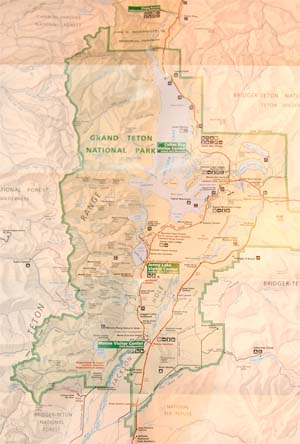 GENERAL PARK INFORMATION - Grand Teton National Park operates all year round. But most facilities only offer services from May through October. Entrance fees cost $35.00 for a seven day stay. The park pass is also good for Yellowstone National Park. A twelve month pass runs $70.00. This purchases a Golden Eagle Passport that is good at all National Parks and National Recreation areas. My wife and I always go this route. We usually visit several National Parks during the year so it is well worth it.
GENERAL PARK INFORMATION - Grand Teton National Park operates all year round. But most facilities only offer services from May through October. Entrance fees cost $35.00 for a seven day stay. The park pass is also good for Yellowstone National Park. A twelve month pass runs $70.00. This purchases a Golden Eagle Passport that is good at all National Parks and National Recreation areas. My wife and I always go this route. We usually visit several National Parks during the year so it is well worth it. If you plan to stay for more than 7 days you can purchase a pass that is good for a full year in the park, but for an additional $10.00 you can get the Golden Eagle Passport. If you plan on visiting other Parks in the U.S. you would probably be much better off with the Golden Eagle Passport. If you are age 62 or older then you can get a Golden Age Passport for only $80.00 that lasts for the rest of your life. What a deal! This is only available if you are a U.S. citizen or resident. If you are planning your trip off season or if you are in any doubt about road conditions (or require any other general information), you can call Moose Visitor Center at 307-739-3399.
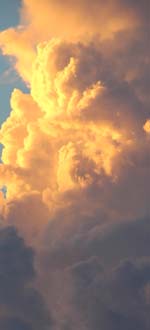 WEATHER - From mid June through August daytime temperatures average between 72 - 85 degrees F. But night time temperatures can still be quite cool even during the summer months. They range from 35-45 degrees F. Days are usually sunny but afternoon thunderstorms can be quite common. Every time I have visited the Grand Teton, I have experienced a thunderstorm or two during our 7 day stays. While climbing the Grand and Middle Teton my son and I experienced a couple of pretty violent thunderstorms. They rarely last long (fortunately) and they can add to the experience of visiting the National Park.
WEATHER - From mid June through August daytime temperatures average between 72 - 85 degrees F. But night time temperatures can still be quite cool even during the summer months. They range from 35-45 degrees F. Days are usually sunny but afternoon thunderstorms can be quite common. Every time I have visited the Grand Teton, I have experienced a thunderstorm or two during our 7 day stays. While climbing the Grand and Middle Teton my son and I experienced a couple of pretty violent thunderstorms. They rarely last long (fortunately) and they can add to the experience of visiting the National Park. Fall in the Tetons is short lived. However, it certainly one of the most beautiful seasons in the Grand Teton. The season usually lasts from mid September through October. By November winter begins to set in. Winter is the longest season by far. It lasts from November through April, and during these months, snow blankets the park and daytime temperatures rarely get out of the twenties. Lows can go well below zero (about -15 degrees F).
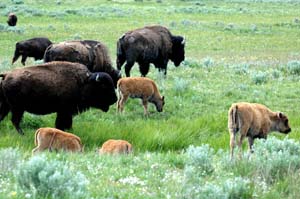 WILDLIFE - The diversity of wildlife in the Grand Teton National Park (and surrounding area) is absolutely incredible. During my stays at the park I have run into black bears, grizzlies (and their cubs), bison, chipmunks, and endless other varieties of critters. Animals have the right-of-way everywhere in the park, including roads, trails, and parking lots. All wildlife can be dangerous and you should view it from a distance. If you should stumble upon a bear or other potentially dangerous animal, never run. This is most peoples reaction, but it is the worst thing you can do. Most large predatory animals are triggered to attack by the fright-flight reaction. Also, never take chances by approaching animals such as bison, bears, or other large animals for that so called perfect photo. Getting too close may just may get you gored by a seemingly docile bison.
WILDLIFE - The diversity of wildlife in the Grand Teton National Park (and surrounding area) is absolutely incredible. During my stays at the park I have run into black bears, grizzlies (and their cubs), bison, chipmunks, and endless other varieties of critters. Animals have the right-of-way everywhere in the park, including roads, trails, and parking lots. All wildlife can be dangerous and you should view it from a distance. If you should stumble upon a bear or other potentially dangerous animal, never run. This is most peoples reaction, but it is the worst thing you can do. Most large predatory animals are triggered to attack by the fright-flight reaction. Also, never take chances by approaching animals such as bison, bears, or other large animals for that so called perfect photo. Getting too close may just may get you gored by a seemingly docile bison.
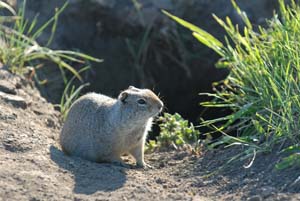 Wet meadows, willow flats, and other wetlands (including the western waterways) contain over 90 percent of the entire region's biological diversity. Moose, river otters, and a whole host of other wildlife congregate in these areas. Ground squirrels, dear mice, and badgers usually hang around the sagebrush flats. Sagebrush colors most of the valley floor and makes up the most visible plant community. Pronghorns live in this type of environment along with badgers, coyotes, wolves, and other critters. There are over 20 different grasses that make up the sagebrush terrain, and elk herds feed on the grasses in spring, summer, and fall. In the alpine zone, animals such as tiny pikas and yellow bellied marmots are plentiful. These animals are very skilled at getting food and if you leave your food unattended they will surely take advantage of it. I remember a time while climbing in the Tetons where I hung my food out of reach high up with a nylon cord. A marmot climbed up and slid down the cord. He hung off the bottom of my stuff sack and chewed a hole through it and ate the food right out of the bottom of the stuff sack. A bear proof canister is the best way to keep your food away from clever animals in the wild.
Wet meadows, willow flats, and other wetlands (including the western waterways) contain over 90 percent of the entire region's biological diversity. Moose, river otters, and a whole host of other wildlife congregate in these areas. Ground squirrels, dear mice, and badgers usually hang around the sagebrush flats. Sagebrush colors most of the valley floor and makes up the most visible plant community. Pronghorns live in this type of environment along with badgers, coyotes, wolves, and other critters. There are over 20 different grasses that make up the sagebrush terrain, and elk herds feed on the grasses in spring, summer, and fall. In the alpine zone, animals such as tiny pikas and yellow bellied marmots are plentiful. These animals are very skilled at getting food and if you leave your food unattended they will surely take advantage of it. I remember a time while climbing in the Tetons where I hung my food out of reach high up with a nylon cord. A marmot climbed up and slid down the cord. He hung off the bottom of my stuff sack and chewed a hole through it and ate the food right out of the bottom of the stuff sack. A bear proof canister is the best way to keep your food away from clever animals in the wild.
Never feed any animal. When animals (especially bears and other large predatory animals) get accustomed to eating human food and garbage they can become aggressive, and much more dangerous to visitors in the park. Make sure you do your part by keeping all your food safely stored away. If camping make sure to prepare your food at least 100 yards from your tent site and never store any food in your tent or sleeping bag. If car camping make sure to remove all food and odorous items from your vehicle. Bears have a very keen sense of smell and have no problem breaking into your vehicle to get an easy meal.
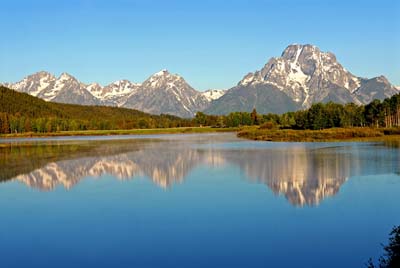 SIGHTSEEING IN THE GRAND TETON - To see Grand Teton National Park in all its glory try an get an early start. Early starts have many advantages. First, you take advantage of the magical lighting at sunrise. This is best for viewing the grandeur of the parks majestic mountains. Second, you will have the best chance of seeing a much wider variety of wildlife. Animals are far more likely to be out in the open during the cool of the early morning hours. I have seen bears, elk, bison, moose, and many other exciting types of wildlife early in the morning. As the day wears on most of these animals take cover to avoid the heat of the day, and are therefore out of view.
SIGHTSEEING IN THE GRAND TETON - To see Grand Teton National Park in all its glory try an get an early start. Early starts have many advantages. First, you take advantage of the magical lighting at sunrise. This is best for viewing the grandeur of the parks majestic mountains. Second, you will have the best chance of seeing a much wider variety of wildlife. Animals are far more likely to be out in the open during the cool of the early morning hours. I have seen bears, elk, bison, moose, and many other exciting types of wildlife early in the morning. As the day wears on most of these animals take cover to avoid the heat of the day, and are therefore out of view.
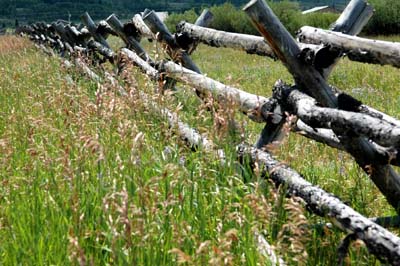 One of the most beautiful locations to visit is Oxbow Bend. This special point has fantastic views of Mt Moran. In the early morning hours the Snake River is usually calm and it offers a mirror like surface that reflects the beauty of the mountains in the background. If this is not enough, Oxbow Bend also is a great place to view wildlife. Exotic birds, moose, bear, and many other forms of wildlife often visit this section of the Snake River and provide the visitor (and photographer) with a multitude of opportunities to see some of Grand Tetons most exciting scenery and wildlife. During the fall season the aspen trees (that grow along the bend in the river) provide a spectacular background for both amateur and professional photographers. Also don't forget the more common sites. Buck and rail fences make for interesting scenes along roadways and farms. The aboveground supports were the settler's innovative solution to avoid digging post holes in the hard and rocky soil.
One of the most beautiful locations to visit is Oxbow Bend. This special point has fantastic views of Mt Moran. In the early morning hours the Snake River is usually calm and it offers a mirror like surface that reflects the beauty of the mountains in the background. If this is not enough, Oxbow Bend also is a great place to view wildlife. Exotic birds, moose, bear, and many other forms of wildlife often visit this section of the Snake River and provide the visitor (and photographer) with a multitude of opportunities to see some of Grand Tetons most exciting scenery and wildlife. During the fall season the aspen trees (that grow along the bend in the river) provide a spectacular background for both amateur and professional photographers. Also don't forget the more common sites. Buck and rail fences make for interesting scenes along roadways and farms. The aboveground supports were the settler's innovative solution to avoid digging post holes in the hard and rocky soil.
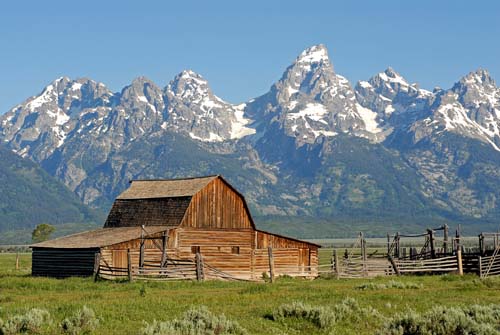 Located one mile north from the turnoff to Moose Junction, the Antelope Flats Road will head east along Ditch Creek bringing one to historic Mormon Row and the vintage establishments of early pioneers. The open fields, which are home to herds of grazing bison in the summer, provide incredible vistas of the Teton Range and an exciting side trip off the beaten path. The Moulton Ranch, still has an acre which is privately owned. The other buildings were allowed to decay buildings were allowed to decay until the 1990s. The Park Service then realized the significance of these buildings and took measures to preserve them. Bison and arrowleaf balsam root make up this sagebrush type of landscape in summer, and a trip to Mormon Row is a must-do. As mentioned above, these grasslands also sport small groups of pronghorn antelope.
Located one mile north from the turnoff to Moose Junction, the Antelope Flats Road will head east along Ditch Creek bringing one to historic Mormon Row and the vintage establishments of early pioneers. The open fields, which are home to herds of grazing bison in the summer, provide incredible vistas of the Teton Range and an exciting side trip off the beaten path. The Moulton Ranch, still has an acre which is privately owned. The other buildings were allowed to decay buildings were allowed to decay until the 1990s. The Park Service then realized the significance of these buildings and took measures to preserve them. Bison and arrowleaf balsam root make up this sagebrush type of landscape in summer, and a trip to Mormon Row is a must-do. As mentioned above, these grasslands also sport small groups of pronghorn antelope.
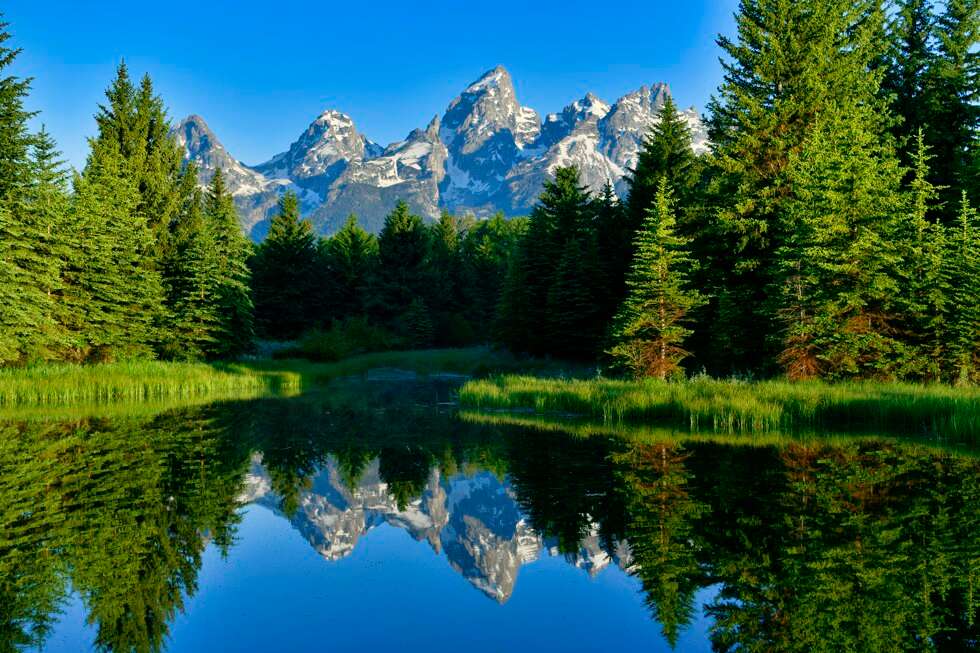 Schwabacher Landing - is another fantastic place to visit in the park. As shown in the photo above, you can see how beautiful Grand Teton can be. It is a short hike from a lower parking lot just off the main road. Wildlife such as beaver, moose, birds, and much more can be seen in this section. As mentioned above, it is best to be at the landing near dawn for best viewing.
Schwabacher Landing - is another fantastic place to visit in the park. As shown in the photo above, you can see how beautiful Grand Teton can be. It is a short hike from a lower parking lot just off the main road. Wildlife such as beaver, moose, birds, and much more can be seen in this section. As mentioned above, it is best to be at the landing near dawn for best viewing.
The Snake River Overlook - as seen to the right is also one of several famous turnouts that you will not want to miss. I consider this point to be about the best spot to see the panorama of the Tetons.
Colter Bay - to the left is another great place to visit. At the bay you can fish, rent a boat, or spend time relaxing while viewing the incredible back side of Mt Moran and its surrounding peaks.
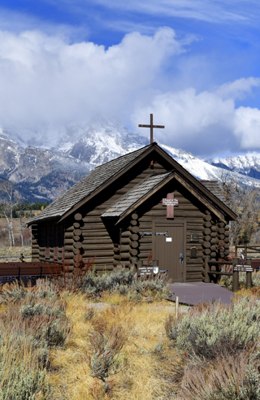 The Chapel of the Transfiguration - is also a must see while visiting the park. It is owned and maintained by St. John's Episcopal Church of Jackson, Wyoming. The chapel is one of the most visited religious structures in America and has been seen and admired by thousands of tourists from all over the world who have visited the Tetons each summer since the chapel was built in 1925.
The Chapel of the Transfiguration - is also a must see while visiting the park. It is owned and maintained by St. John's Episcopal Church of Jackson, Wyoming. The chapel is one of the most visited religious structures in America and has been seen and admired by thousands of tourists from all over the world who have visited the Tetons each summer since the chapel was built in 1925. The chapel was purposely built in the center of the dude ranch country. It was erected through private contributions as a venture of faith, and is an example of how the early settlers in the valley met their needs by sharing resources. The land was donated by Maud Noble, money was donated by the dude ranches, and labor was donated by those the chapel would serve.
Most people photograph and view the church from the exterior, but the interior is also beautiful. The chapel is certainly worth visiting, and is a great place to slow down and reflect on the more important things in life.
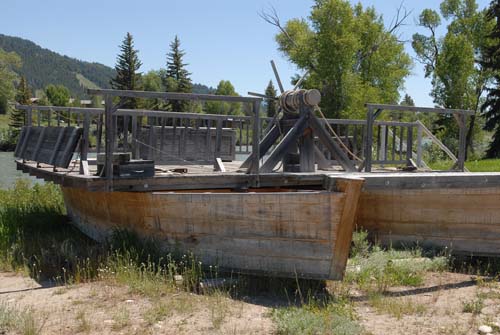 Menor's Ferry - is another great attraction located within the Grand Tetons borders. Turn off the Teton Park Road 0.5-mile north of Moose. The Menor's Ferry Trail, (less than 0.5-mile long), affords a look at homesteading and pioneer life in Jackson Hole. You can visit Bill Menor's cabin and country store. I always like visiting this section of the park. It has a lot of antique furniture and turn of the century artifacts that are very interesting to look at. As far as the ferry, Menor charged 50cents for a wagon and team and 25cents for a rider and horse. Pedestrians rode free if a wagon was crossing. When the water was too low for the ferry, Menor suspended a platform from the cable and three to four passengers could ride a primitive cable car across the river. In later years, Menor and his neighbors built a bridge for winter use and dismantled it each spring. Menor sold out to Maude Noble in 1918.
Menor's Ferry - is another great attraction located within the Grand Tetons borders. Turn off the Teton Park Road 0.5-mile north of Moose. The Menor's Ferry Trail, (less than 0.5-mile long), affords a look at homesteading and pioneer life in Jackson Hole. You can visit Bill Menor's cabin and country store. I always like visiting this section of the park. It has a lot of antique furniture and turn of the century artifacts that are very interesting to look at. As far as the ferry, Menor charged 50cents for a wagon and team and 25cents for a rider and horse. Pedestrians rode free if a wagon was crossing. When the water was too low for the ferry, Menor suspended a platform from the cable and three to four passengers could ride a primitive cable car across the river. In later years, Menor and his neighbors built a bridge for winter use and dismantled it each spring. Menor sold out to Maude Noble in 1918.
She doubled the fares, hoping to earn a living from the growing number of tourists in the valley. Noble charged $1 for automobiles with local license plates, or $2 for out-of-state plates. In 1927, a steel truss bridge was built just south of the ferry, making it obsolete. Maude Noble sold the property to the Snake River Land Company in 1929. Bill Menor and his neighbors homesteaded there thinking of the local natural resources as commodities for survival. But many of them grew to treasure the beauty and uniqueness of Jackson Hole. In 35 short years, from Bill Menor's arrival until the establishment of the original park in 1929, this land passed from homestead to national treasure. (Above Info on Menor's Ferry from Official Grand Teton Site) Below are a couple of photos of the interior of Bill Menor's cabin.

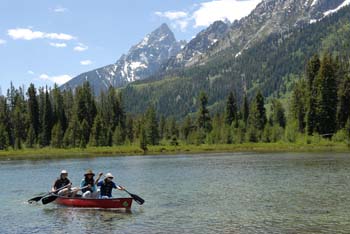 WATER ACTIVITIES - The Snake River along with beautiful lakes, streams, marshes, and other waterways, provide the enthusiast with plenty of opportunities for top notch recreation and fun. Mad River (800-458-7238) along with other concessions offer superb float trips, white water rafting excitement, and other river adventures on the Snake River. Take advantage of all they have to offer.
WATER ACTIVITIES - The Snake River along with beautiful lakes, streams, marshes, and other waterways, provide the enthusiast with plenty of opportunities for top notch recreation and fun. Mad River (800-458-7238) along with other concessions offer superb float trips, white water rafting excitement, and other river adventures on the Snake River. Take advantage of all they have to offer.
It is also easy to plan your own water activities such as kayaking and canoing. Local rental companies in the area will rent you both motorized and non-motorized water craft that you can operate on your own. In the image above to the left, above, you see park visitors canoing on String Lake. This particular lake is shallow, calm, and fairly warm during summer months. It is the perfect lake for this type of activity. The surrounding beauty is simply breathtaking. It is a wonderful way to relax and enjoy Grand Teton at it's best.
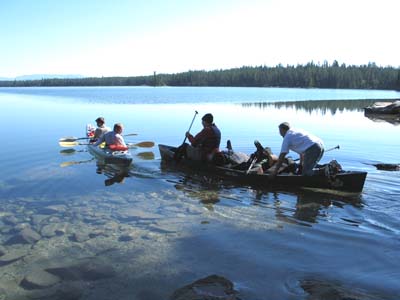
Leigh Lake - is another great Teton Lake for self-propelled water craft. To take advantage of water fun on Leigh Lake you need to make a short portage between String Lake / Leigh Lake. The park service provides clear markings and a well maintained path for you to carry your canoe or kayak on. Our page on Mt Moran describes this portage and provides additional photos if you are interested in boating on Leigh Lake. Leigh is a much larger lake than String Lake, but still offers beautiful views and other fun activities for you to enjoy.
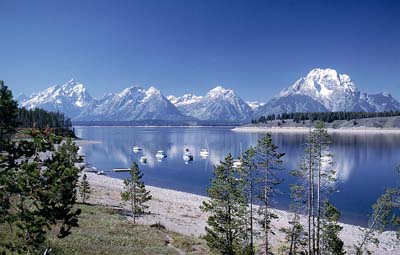 Jackson Lake - as shown in the image
to the left
above
is the largest body of water in the park. It lies at an elevation of 6,772 Ft, and in some places reaches a depth of 400 Ft. It is surrounded by some of the greatest beauty that you can imagine. Jackson Lake, located in the northern half of the park, features Colter Bay, Jackson Lake Lodge, and Signal
Jackson Lake - as shown in the image
to the left
above
is the largest body of water in the park. It lies at an elevation of 6,772 Ft, and in some places reaches a depth of 400 Ft. It is surrounded by some of the greatest beauty that you can imagine. Jackson Lake, located in the northern half of the park, features Colter Bay, Jackson Lake Lodge, and SignalMountain. The setting as mentioned above, offers spectacular views of Mt. Moran and the Cathedral Group. Activities in and around the lake include camping, canoing, boating, fishing, hiking, sailing, water
skiing, swimming and wind surfing. The lakes above do not allow motorized boats, so Jackson is the best lake for these types of water craft. We usually opt for a motor boat over a canoe or other form of self propelled vessel when boating on Jackson Lake. This is because of the tremendous size of the lake. Too much work to paddle around this lake!
Water Safety - As you can imagine, boating and rafting are popular in the Grand Teton. But there are no lifeguards at the parks lakes. No inner tubing is allowed on the Snake River due to its hazardous currents. If you are backpacking or camping in the park and want to make use of the water in the lakes and streams for drinking and/or cooking, be sure to treat it first. Harmful microorganisms such a as Giardia lamblia can be present. So make sure to filter, boil, or chemically treat the water.
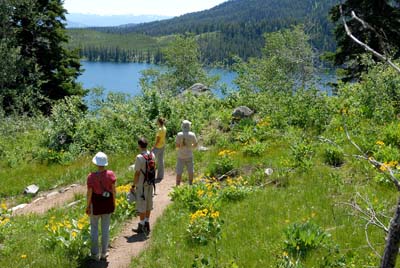 HIKING & BACKPACKING - Foot travel in the park is varied and exciting. Grand Teton National Park has over 220 miles of well maintained trails that range from easy meandering pathways to trails up rigorous canyons and high mountain passes. You will find many books and maps in the parks general stores and markets that will describe the parks many pathways and trails. They will also give great suggestions on the best places to take a hike or backpack. Also do not forget to take advantage of the advice from the Park Rangers. They have much experience in the back country. We found the Taggart/Bradley lake hike to be a great beginners path that traverses beautiful meadows, lakes, and wild flowers in season. The Garnet Canyon Trail leads to the upper meadows and gives access for climbs up the Grand, Middle, and South Teton. This trail is more strenuous but is well worth the effort if you have the energy. The views Grand Teton and Middle Teton along the way are truly spectacular. Overnight says in the wilderness require a back country permit. They are issued free of charge, and you can pick them up at any of the parks ranger stations.
HIKING & BACKPACKING - Foot travel in the park is varied and exciting. Grand Teton National Park has over 220 miles of well maintained trails that range from easy meandering pathways to trails up rigorous canyons and high mountain passes. You will find many books and maps in the parks general stores and markets that will describe the parks many pathways and trails. They will also give great suggestions on the best places to take a hike or backpack. Also do not forget to take advantage of the advice from the Park Rangers. They have much experience in the back country. We found the Taggart/Bradley lake hike to be a great beginners path that traverses beautiful meadows, lakes, and wild flowers in season. The Garnet Canyon Trail leads to the upper meadows and gives access for climbs up the Grand, Middle, and South Teton. This trail is more strenuous but is well worth the effort if you have the energy. The views Grand Teton and Middle Teton along the way are truly spectacular. Overnight says in the wilderness require a back country permit. They are issued free of charge, and you can pick them up at any of the parks ranger stations.
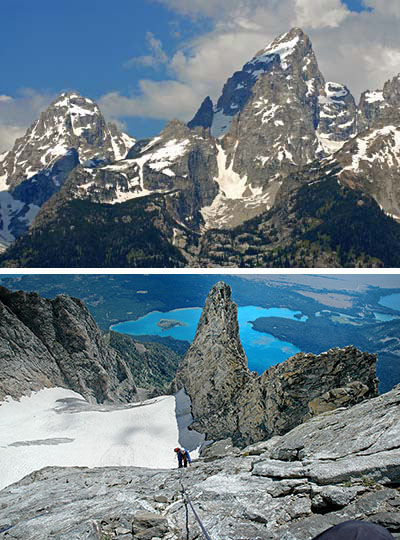 MOUNTAIN CLIMBING - in the Grand Teton is world famous. The peaks in the park rise abruptly, and culminate with fantastic spires, pinnacles, and sharp summits. The rock is generally sound and offers the climber excellent opportunities for fine mountaineering experiences. There are climbs that are appropriate for novices, as well as extremely difficult mixed alpine climbs that provide a testing ground for climbers aspiring to advance to even greater climbs throughout the world. The fact that the Tetons rise over 7,000 ft above the flat plains of Jackson Hole make them an incredibly exciting place for climbers of all abilities.
MOUNTAIN CLIMBING - in the Grand Teton is world famous. The peaks in the park rise abruptly, and culminate with fantastic spires, pinnacles, and sharp summits. The rock is generally sound and offers the climber excellent opportunities for fine mountaineering experiences. There are climbs that are appropriate for novices, as well as extremely difficult mixed alpine climbs that provide a testing ground for climbers aspiring to advance to even greater climbs throughout the world. The fact that the Tetons rise over 7,000 ft above the flat plains of Jackson Hole make them an incredibly exciting place for climbers of all abilities.
Another advantage of climbing in the Tetons, is their great accessibility. Peaks are only a short distance from main highways. The summit of the Grand is only three horizontal miles from the nearest approach road. The Tetons have been more intensively climbed than any other range of equal size on the entire continent. The Grand Teton shown in the upper right hand image has no less than 38 established routes, and tops out at 13,770 ft. making it the second highest peak in Wyoming.
Mt Moran shown to the right also has many fine routes. The CMC route is one of the most famous routes on the peak. Mt Moran is best approached by using one of its surrounding lakes. Climbers simply paddle into position and avoid the nasty brush along the lake banks. As mentioned above, back country permits are required for all overnight stays in the park, and this goes for climbers too. This is about the only red tape involved. Most climbers pick up these permits at the Jenny.
Well, that's just a few samples of things to see and some of the key points to visit in the Grand Teton. Make sure while you are in the park to pick up brochures, maps, and sightseeing guides so that you will be able to get the most out of your visit. There is so much to do and so much to see, and you will not want to miss a thing (if time permits). Email Sign Up
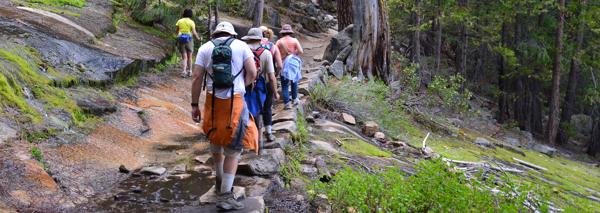
| Join the Adventure! Sign up here for Timberline Trails Monthly Newsletter |

Join us on Instagram

©2006-2022 TimberlineTrails. All Rights Reserved.